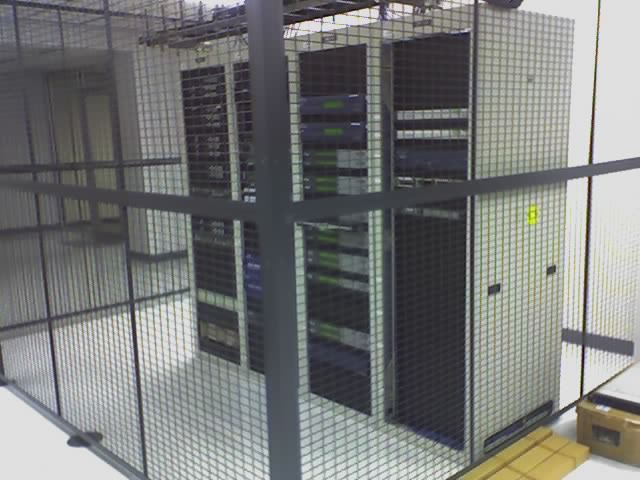
The company I work for has a few servers in the same server room that houses both the Dish Network and DirecTV local receive equipment.
Whenever I visit the facility, (which isn't often, our servers are very reliable), I never remember to bring a decent camera.
Last time I visited, I took some photos with my old cell phone camera, and post them, with commentary, here, in case anyone is interested in what a "local receive facility" looks like.
Ironically, about a week after taking these photos, I got a new cell phone with a much better camera in it. These photos were taken on July 28, 2010.
The facility is the Integrated Data Systems datacenter.
Here are some of the high-uptime features of the facility:
CAT 5 Hurricane Rated
3600 sq/ft customer area
50 Ton Redundant Cooling Plant (triple redundancy)
3200 AMP 3 Phase Power Service (two different sub-stations with automatic changeover)
6000 AMP DC Power Service
Inverted 120/240 Power options
Multi-Fiber Feeds
250 KW Diesel Turbine Generator (3800 gal. Fuel)
300 KW Natural Gas Generator
Most clients choose to power their equipment through the -48 volt DC power system, deriving 120 (or 240) volts via a voltage inverter. The inverter systems, if they fail, switch over to the AC mains and sound an alarm so that they may be promptly serviced. The DC service is truly uninterruptible. The DC power system has the capacity to run all the servers in the facility for 6 to 8 hours with the AC power down. It's unlikely it would ever be called upon to run for that long, however, since one of the two generators (either of which can power the entire facility, including lights and air conditioning) would be on line within a couple of minutes of AC mains failure. The fuel capacity of the diesel generator is enough to run the facility for 1 week, but it is the secondary generator. The primary, the Natural Gas, will obviously run as long as natural gas service is present. (The neighborhood where this facility is located did not lose natural gas service even during Katrina.)
Here's a pic of DirecTV's equipment in the server room:

The fence around the equipment is ostensibly for security, and that's surely part of it. But there's a "museum display" quality about DirecTV's installation here. They clearly want geeks to gawk at it and wonder at its beauty. This is in contrast to Dish Network's approach, which we will see in a moment. Employees of Integrated Data Systems have told me that DirecTV, indeed, pays a handsome monthly fee to occupy this much floor space in the server room!
DirecTV's equipment is running off the -48 volt DC power system, via an inverter as described above.
Here's a closup of DirecTV's receivers:
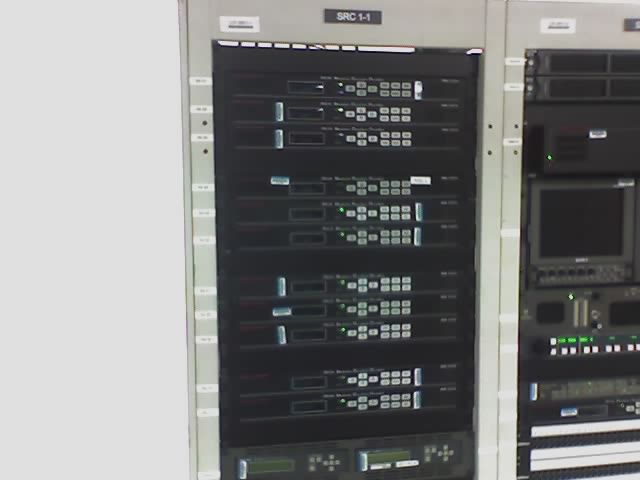
The shot above is of the leftmost rack in DirecTV's installation. It contains 11 single tuner modules and one double tuner module, for a total capacity to tune in 13 channels (DirecTV carries 10 New Orleans locals, 8 of them in HD and SD, 2 in SD only).
The rack to the right of the above picture also contains 1 tuner, which I suspect is for maintenance purposes; tweaking antennas, etc. The rack to the right also contains a monitor with a speaker (which on a previous visit was displaying WVUE, picture and sound), a couple of non-descript servers, and some devices that I believe have to do with remote control of the system.
Here is a closeup of the third rack over in DirecTV's installation:
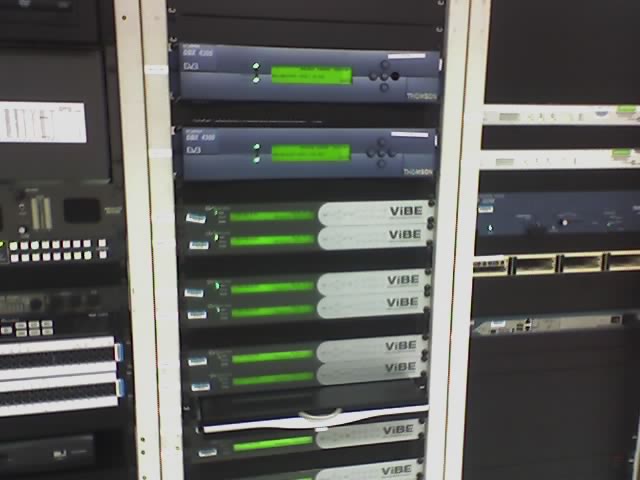
The devices labeled "ViBE" in the above picture are transcoders. They convert the picture and sound from its OTA CODEC to whatever CODEC DirecTV uses to back-haul the signals (Probably an MPEG-4 CODEC, but I don't know that for sure.)
There are 13 transcoders, matching the number of receivers in the left-most rack. Apparently, DirecTV has the capacity to receive and back-haul 13 channels in New Orleans. (Or, since they are carrying 10 New Orleans channels, they have a redundancy of 3 on each of these pieces of equipment.)
The blue boxes on the top are multiplexers, they combine the transcoded channels into one bit stream for backhaul via fiber. Since there are two identical units, I assume one is a primary and the other is a backup.
Since analog TV is shut down, DirecTV needs to receive each channel only one time to carry both HD and SD versions on their system. The HD version of each channel is backhauled to their uplink facility, and the SD version that they carry is center-cut and converted to 480i there.
Here's a pic of Dish Networks's equipment in the server room:
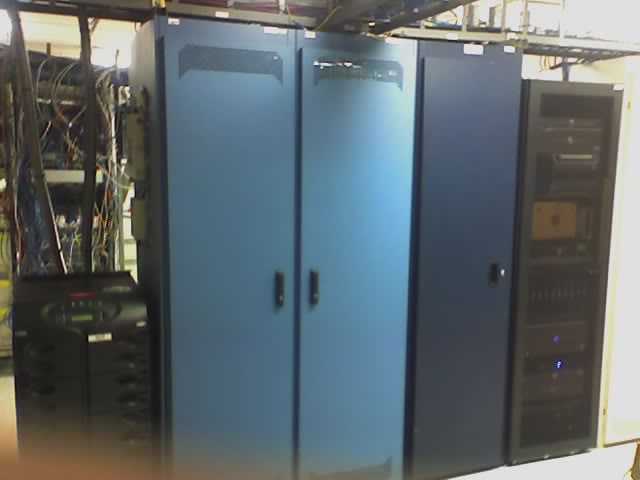
Their equipment consists only of the UPS on the left, and the two light-blue cabinets. (The dark blue/grey cabinet and everything to the right of the light blue ones is something else, not Dish Network's stuff.)
Obviously, unlike DirecTV, Dish has gone for the "stealth" approach in their installation. I might not have found their equipment if an Integrated Data Systems employee had not once pointed it out to me.
One can only assume, that packed into those two blue racks, is equivalent equipment to that DirecTV openly displays.
Here's the only outward clue who's equipment it is:
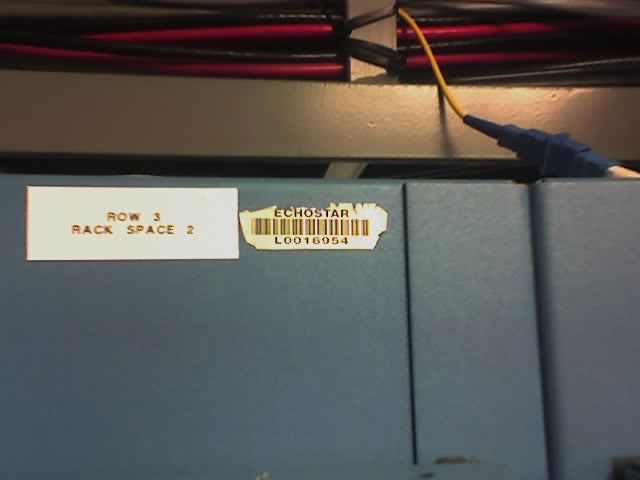
Here's a closup of Dish Network's UPS:
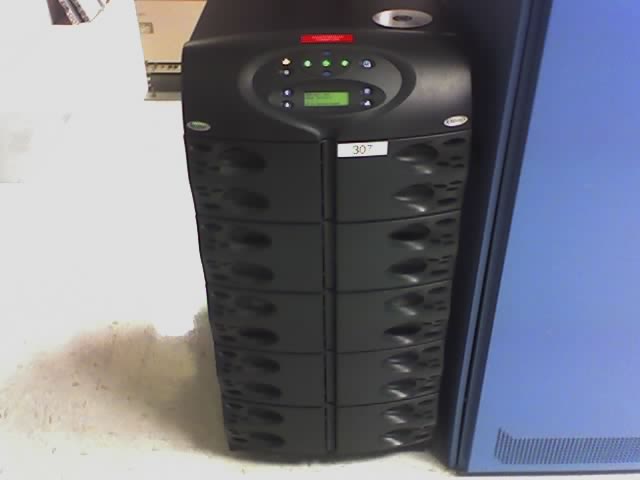
For whatever reason, Echostar decided to plug directly into the AC mains and use their own UPS, rather than use the -48 volt DC system available to all tenants in the building. Their UPS should carry them through until the generator kicks in, however.
The red sticker on the UPS reads "Echostar Main UPS".
Here are some of my other picture tours:
My tour of the New Orleans TV towers.
Take a tour of the WVUE Studios.
 Email me:
<marksu@spectra-one.com>
Email me:
<marksu@spectra-one.com>